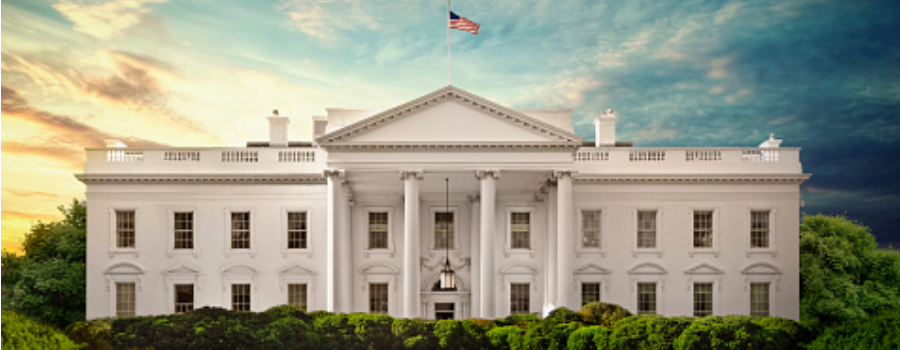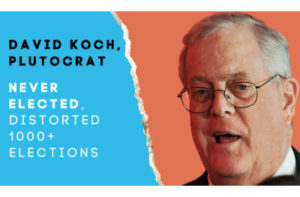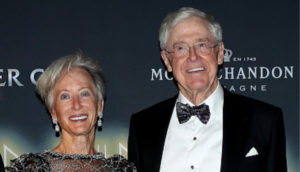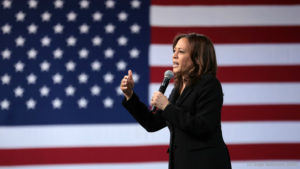Two groups from outside of Wisconsin may have been responsible for President Donald Trump’s narrow win in the state in 2016, according to a recently obtained “confidential” report. (This article was first published in the Progressive.)
Between October 29 and November 7, 2016, sister groups Independent Women’s Voice and Independent Women’s Forum, two nonprofits based in Washington, D.C., launched a campaign to target registered independents and Republican-leaning women in Wisconsin. These efforts moved independent voters in the state by 16 percentage points toward Trump, says the report, which was prepared for both groups by Daron Shaw, a professor at the University of Texas, Austin.
The groups have used their “independent” brand name to appeal independents, an advantage Higgins touted to donors at an event in 2015: “Being branded as neutral, but actually having people who know that you’re actually conservative puts us in a unique position.”
The groups targeted approximately 1.54 million registered voters with multiple choice and ‘true or false’ quizzes, consisting of questions on the Affordable Care Act and the U.S. Supreme Court. The quizzes were delivered via digital outreach, postcards, and phone calls starting eleven days before the 2016 presidential election.
Heather Higgins, an heiress to the Vicks VapoRub fortune who has led the groups’ boards for years, summed up Shaw’s findings: Had the quiz messaging not occurred, “Trump would have received an estimated 215,840 fewer votes in Wisconsin, the state completely written off by all the political professionals.”
Her website for the group added that without the groups’ intervention, “both Trump and [Wisconsin Republican U.S. Senator Ron] Johnson would otherwise have lost Wisconsin by over 100,000 votes each.”
Trump won the popular vote in Wisconsin by less than 23,000 votes.
True North Research, a research organization I founded and lead, has just issued a report about the groups, whose election-season activities flew below the radar of most national and state media outlets. It documents the groups’ involvement in the 2016 election, as elucidated by Shaw’s report, which was obtained by True North last year.
As Shaw’s description of Higgins’s strategy highlighted, most of the funding to influence women voters came from the Independent Women’s Forum, the 501(c)(3) arm of the duo.
That’s troubling, Marcus Owen, the former head of the agency’s tax-exempt organizations division, told the Center for Media and Democracy. He noted that the IRS stipulates that 501(c)(3) charities “must avoid any issue advocacy that functions as political campaign intervention,” whether they name a candidate or not.
Shaw suggested in his report that the potency of the messaging by the Independent Women’s Forum and Independent Women’s Voice was attributable in part to the power of repeated quizzes to reinforce the answers suggested. As he explained it:
“[E]ven relatively modest quiz messaging can have an impact on people, especially with respect to their knowledge of issue and policy arguments. However, to persuade people about the salience of the issue, or to move broader attitudes on the issue, it seems that multiple ‘touches’ and different modes of outreach are necessary, as we saw in the Wisconsin test.”
The Independent Women’s Voice used its outreach to tie those issues to the election.
Shaw found that the quizzes made Wisconsin independents 16 percent more likely to vote for Trump. He also found that the quizzes were more effective with Republican and independent women than with men in making women “more likely to support Trump over Clinton” (17 percent versus 11 percent).
Since 2010, Independent Women’s Voices has been deploying women to tell other women to worry about government health insurance interfering with their access to doctors.
The groups have used their “independent” brand name to appeal independents, an advantage Higgins touted to donors at an event in 2015: “Being branded as neutral, but actually having people who know that you’re actually conservative puts us in a unique position.”
Although the quizzes were not included in Shaw’s report, the website for Independent Women’s Voice has quizzes on the Affordable Care Act (ACA) and on the importance of the U.S. Supreme Court (from when Senator Mitch McConnell was blocking President Barack Obama’s ability to appoint Merrick Garland). Another quiz combines the two issues.
Since 2010, Independent Women’s Voices has been deploying women to tell other women to worry about government health insurance interfering with their access to doctors. The group has also created numerous sites attacking the ACA, particularly around pivotal elections.
Higgins’s groups poured millions into ads and other marketing efforts in 2016. Although the amount spent in Wisconsin alone was not reported, the two groups spent a combined total of more than $3.7 million that year. The Independent Women’s Forum carried the bulk of that expense, spending more than $2.5 million on what they called “active engagement and market evaluation.”
Independent Women’s Voice also spent almost $700,000 on “active engagement” and communications, plus nearly $500,000 on polling in 2016.
In contrast, in 2015, the two groups spent only $12,000 on what they called active engagement.
Since 2016, my research found that the groups have raised nearly $20 million, not counting any funds raised in the past fourteen months. In the last presidential election year, donors gave them more than $8 million. That year, they targeted Wisconsin, Pennsylvania, and New York, but Shaw concluded their messaging was not as effective in the latter two states, where there was more “noise” from spending by others.
The Independent Women’s Voice also issued individual press releases applauding sixty-eight members of Congress who were re-elected after signing a repeal “Obamacare” pledge, including one for Senator Johnson of Wisconsin.
How much the groups will raise and spend this year is not yet known.
Higgins has been focused on Wisconsin since at least 2011, when her groups worked to influence voters’ views of unions as Republican Governor Scott Walker faced a potential recall from office. She later claimed the Independent Women’s Voice played a decisive role in his success in remaining in office.
Here’s how she described that race:
“IWV’s research showed that the core belief among Independents who opposed Gov. Walker’s reforms was that public employees are underpaid and are making a sacrifice to hold those jobs. Through our educational program, we changed this foundational belief into an understanding that unionized public employees are overcompensated relative to the private sector.”
According to Higgins, “support for Scott Walker increased by 31 points among 10,000 likely voters who received our message . . . even though we made no reference to Walker, his reforms, or the recall.”
The Independent Women’s Voice and Independent Women’s Forum grew out of a group of women who were friends of Clarence Thomas and defended him against allegations of sexual harassment during his Supreme Court confirmation hearing in 1991.
They argued, essentially, that because he had not sexually harassed them, he could not have harassed Anita Hill, despite her testimony under oath. Thomas, who angrily denied Hill’s charges, was confirmed to the U.S. Supreme Court.
Since then, the Independent Women’s Forum has countered the unequal pay claims of the U.S. women’s soccer champions and opposed Title IX’s guarantees for equal opportunity for athletics for women and girls, among other things.
More recently, the group has attacked a proposal to add a small payroll tax to fund paid leave to care for oneself or a loved one, and urged instead that parents borrow from future Social Security payments to cover time off for a newborn.
Independent Women’s Voice has also repeatedly backed male candidates over women, as when it helped Scott Brown, a Republican U.S. Senate contender in Massachusetts, beat Martha Coakley in 2010. Three years later, Independent Women’s Voice claimed to have played “a unique and critical role” in South Carolina Republican Mark Sanford’s Congressional election win against Democrat Elizabeth Colbert Busch. It even made $176,991 in independent expenditures on behalf of Richard Mourdock in 2012, after the Republican contender for U.S. Senate in Indiana said that, when a woman gets pregnant from being raped, “it’s something God intended.”
And both groups went to bat for Brett Kavanaugh, as he denied attempting to sexually assault Dr. Christine Blaisey Ford.
The Independent Women’s Voice received $4 million from the Freedom and Opportunity Fund, one of conservative operative Leonard Leo’s dark money groups, as they fought to keep President Obama’s nominee from getting a hearing and while helping make sure President Trump’s nominees were confirmed.
In the Trump Administration, the leaders of these two women’s groups are gaining an even larger voice.
In 2018, Heather Higgins was appointed by then-House Speaker Paul Ryan to the U.S. Commission commemorating the centennial of the passage of the 19th Amendment, giving women the right to vote. Last November, she was invited to the Oval Office as Trump signed a bill to honor this occasion with a commemorative $1 coin.
Kellyanne Conway, a White House counselor, is a former director on the Independent Women’s Forum board and for years was one of the pollsters the Independent Women’s Voice used in Wisconsin and elsewhere.
Political observers have long debated how Trump was able to win Wisconsin in 2016. Pundits often cite Trump’s digital campaign, the Republican’s efforts at voter suppression, Hillary Clinton’s failure to visit Wisconsin after Bernie Sanders won the primary, third party votes for Jill Stein, and even documented Russian interference. But the press in Wisconsin has largely failed to cover the role of these stealthy “independent” women’s groups.
Whether the groups played as big a role as Higgins claims may never be known. The only question now is whether she will repeat the same game plan in Wisconsin and other swing states in 2020. If so, we need to make sure folks are paying attention this time.




